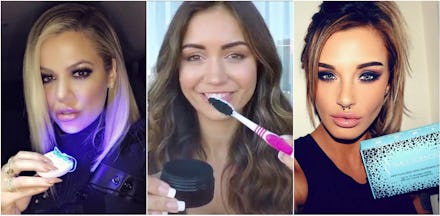Getting White Teeth Has Officially Become One More Beauty Essential to Stress About

If you think the biggest beauty trend on Instagram is a hair color or contouring trick, just take a second peek. Those shiny blue lights, shaped like a smile and held up to every other celebrity mouth? Yup, teeth are the big beauty trend you're about to be talked into for your everyday routine.
We've been seeing the slow creep of teeth into our beauty routines for some time now. While tooth whiteners are nothing new — Crest Whitestrips were introduced in 2001 and have undergone a variety of revamps — the past few years have seen the steady shift of whitening and oral care from the toothpaste aisle into the realm of beauty products.
Read more: I Tried Painting the "Perfect" Face According to YouTube — Here's What Happened
No longer are we limited to whiteners. Now, we can get our hands on things like lip loofahs and charcoal toothpaste, the latter of which has become a social media hit, thanks in part to brand Warpaint and Instagram-famous brand ambassador Pia Muehlenbeck. (Even big brand Colgate has released a version in Asia.) We can now find toothbrushes at Sephora and even whiten our teeth with real diamond dust, and many dental products are marketed as cosmetics first, oral care second. There's even an industry term for it now, "oral care cosmetics," used by companies like Apa Beauty.
"The oral care industry has become more popular from a beauty perspective, and that's why your average toothpaste and brush just doesn't cut it anymore. To care for your teeth is no longer a nuisance, it is more like fashion," Warpaint founder and CEO Petra Konig, a paramedical aesthetician, told Mic in an email.
"Beauty and oral care is an everyday event now."
Part of oral care cosmetics' popularity can probably be attributed to the inescapable celebrity promoters. Stars like Scott Disick, Amber Rose and an endless assortment of Kardshians plug all manner of tooth whiteners online, particularly the ubiquitous blue lights of Express Smile Atlanta and Smile Sciences (which calls its product "teeth whitening beauty makeup") that claim to whiten teeth with LED light — even though some of them are only questionably effective. You can also buy similar kits at Sephora, picking them up alongside your lipstick for $85.
It's just the latest in increasingly intricate beauty expectations. The fixation on teeth isn't brand new, of course. But it might also be a reflection on our cosmetic values: Have perfect, pearly white teeth become yet another impossible beauty standard we must uphold?
In short, yes — and you can tell because the younger generation, more in tune with new trends, are far more committed to white teeth than their older counterparts.
"Our older clients are less interested in the care of maintaining their smiles in comparison to other health-related issues," Dr. Emanuel Layliev, a dentist at the New York Center for Cosmetic Dentistry, told Mic in an email, "whereas our younger clients are not only interested in how beautiful we can make their smiles, but because they are more aware and more educated on technology, they are much more willing to upkeep not just the beauty aspect, but the health aspect of their teeth, too."
Konig agreed, suggesting that oral care cosmetics could take the place of, well, regular cosmetics (which makes sense given her line of work).
"Beautiful teeth lifts people's confidence," Konig told Mic in an email. "You do not need heavy makeup or expensive clothes. A person with a beautiful smile will always stand out. It opens doors."
So just how strong is our desire for a shiny white smile? Have we been buying it — maybe even to the exclusion of other makeup — or are oral care cosmetics just another fleeting beauty trend?
Based on the numbers, this particular beauty market is thriving and unlikely to die away anytime soon. Oral care overall is a more than $5 billion per year industry (though still much smaller than the U.S. cosmetics industry), and the tooth whitening business in particular is expected to grow at a rate of nearly 4% from 2015 to 2019.
According to a 2012 survey by the American Academy of Cosmetic Dentistry, 70% of patients receiving whitening treatments were female. The AACD reports that in 2015, 86% of patients seeking cosmetic dentistry did so to improve physical attractiveness and self-esteem.
And we're only seeing more products, from the inescapable blue lights to the bottles lining Sephora — not CVS — shelves. For many people, white, slick, shiny smiles have pretty much already joined the long, long list of society's beauty standards, alongside recent crazes like contoured cheeks and lush lashes.
So if some fancy toothpastes and high-end brushes are all it takes to improve our self-esteem, that might be something to smile about. If we decide that's too much effort, however, and we'd rather leave this particular trend in the dust, we only have about a zillion other beauty trends to fall back on.